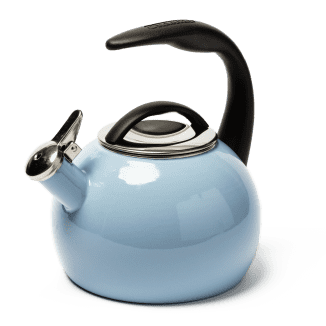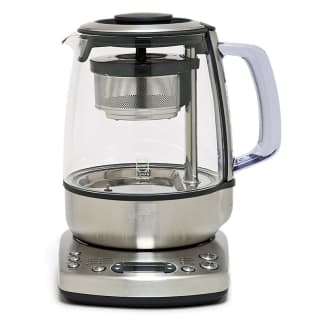Stovetop kettles are simple vessels for heating water. But anyone who’s had a bad one knows how irritating they can be. Poor kettles are apt to whistle too faintly or painfully loudly, rattle and clank on the burner, and be too cumbersome to hoist—or, conversely, too tiny to make a full-size pot of tea. Their handles can get too hot, they can make a splashy mess when pouring, and they can send steam up to scorch your hand. They rust or dent and get grungy living on the stove, where they’re on display for all to see. Still, we had faith that there were good, functional, durable kettles out there—we just had to find them.
To do so, we bought several kettles in a variety of materials, from stainless steel to enamel-coated steel to borosilicate glass, with capacities ranging from 0.84 to 3 quarts. We put every model through a gamut of tests, evaluating how easy it was to fill and lift, as well as how long it took to reach a boil. We boiled water in each kettle multiple times, at both its maximum and minimum capacities, and had a variety of testers pour out hot water into a single mug, trays of teacups, a 1.5-quart teapot, and a filter cone to make pour-over coffee, evaluating how difficult or easy it was to control the pouring. We also got each kettle dirty and banged it around before rating it on ease of cleaning and durability.
Our first discovery was that the practical capacity of some of the kettles was much smaller than advertised: When we filled them to their stated capacities, the water went right up to the brim, causing overflow at the boil. The worst offender held almost a quart less than advertised. Rule of thumb: Most kettles should be filled to just under the interior spout opening.

While the majority of the kettles were easy to fill, with wide openings and good interior visibility, a few were cramped and dark, making it difficult to judge when they were full. The worst had a black enamel interior; we had to pull out a flashlight, or even stick a finger in, just to be sure the water was below the spout. What’s more, this kettle’s opening had a low, fixed handle curving over it that made it hard to access.
Once boiling, the whistling kettles were a boon, but only if we could hear the whistle from the next room. One was so quiet that you had to guess if it was making noise from barely 3 feet away. We found two styles: whistles that you can disable and ones that you can’t. We preferred the two kettles that let you turn off the whistle if you want it to boil silently.
Most of our lineup boiled a full kettle of water in a reasonable time, roughly 8 to 11 minutes, but there were a few outliers that were much slower due to their design. With stern instructions to keep the heat at low to medium, it took 18 to 30 minutes to boil a full pot—we’d be late for work if we waited for that. When pouring into cups, pots, or coffee-filter cones, some kettles were imprecise and harder to control, splashing and glugging, but the best were easy to pour precisely with nary a drop spilled. As for capacity, we wanted a kettle that was roomy but not too heavy. While it’s nice to be able to boil a large volume, the biggest kettle was heavy when empty and weighed upwards of 7½ pounds when full. Another, a gooseneck kettle, was lightweight and was testers’ favorite for precise pouring, but it ran out before our teapot was full. Our favorite model poured almost as smoothly as this small kettle and held almost as much as the biggest kettle but at a fraction of its weight.

To see how easy the kettles were to clean, we sprayed their exteriors with cooking oil and heated them to bake it on. Once they had cooled, we tried to scrub it all off. Kettles lost points for having nooks and crannies that trapped pockets of grease or for not being fully clean after being scrubbed with hot soapy water. To simulate years of knocking around a busy kitchen, we rapped kettles sharply on their sides with a wooden spoon and dropped them repeatedly from 3 inches above the countertop and then checked for dents or damage. A few showed minor dings from being struck, but one kettle had actually acquired a bigger dent during routine use, before we began our abuse testing.
While a few manuals instructed us never to leave kettles damp inside, we think patting dry the interior of a stovetop kettle after every use is wildly impractical and expect more from our tools. We left the kettles damp, with their lids on, over the weeks of testing to see if any would rust. While we didn’t see any rust, two kettles developed a brownish residue on their insides that we could see when we wiped them out with a paper towel—ew. In a taste test of water boiled in these kettles, both passed with a majority of favorable opinions, but both also garnered a few comments about a slightly metallic, stale taste.
In the end we found three kettles we fully recommended, with one standout. The Chantal Enamel-on-Steel Anniversary Teakettle Collection (2 QT.) is roomy and sturdy but relatively lightweight for its size, and it has a loud whistle, which can be disabled if you choose to leave the spout open. Its raised, open handle keeps hands away from hot steam and leaves plenty of space for opening and filling the kettle. It pours well and comes in several colors, all at a moderate price. It’s our new favorite stovetop kettle.
The Tests:
- Weigh kettles empty and full
- Measure actual capacity
- Gauge ease of filling
- Gauge ease of pouring by boiling full kettle and then pouring one cup and multiple cups, filling a large teapot, and making pour-over coffee
- Time how long it takes to boil a full kettle of water
- Have a variety of users handle and evaluate ease of use
- Taste water for off-flavors
- Test for durability by scrubbing off baked-on oil, leaving wet to examine for rusting, repeatedly whacking with wooden spoon, and dropping from 3 inches above counter
How We Rated:
- Performance: We preferred kettles that boiled reasonably quickly, signaled clearly when they were done, poured in a controlled and accurate way, and had sufficient capacity without being too heavy to handle.
- Ease of Use: Kettles that were easy to fill and pour from; felt comfortable, safe, and secure to use; and kept our hands away from hot water, steam, and hot surfaces received higher marks. We preferred kettles with light-colored interiors.
- Cleanup/Durability: We preferred kettles that were easy to clean, that had few nooks and crannies, and that could be scrubbed without lasting damage. Kettles that endured everyday abuse during testing, as well as being knocked with a wooden spoon and repeatedly dropped from 3 inches above the countertop without damage, rated highest. Kettles that resisted brown, slimy buildup were preferred.
- Large capacity without excess weight
- Easy to fill: wide opening, fold-down handle, and good visibility of interior
- Comfortable, secure handle that stays cool
- Loud whistle that you can shut off, if desired
- Smooth, precise pouring
- Durable and rust-resistant
- Simple shape that’s easy to clean























